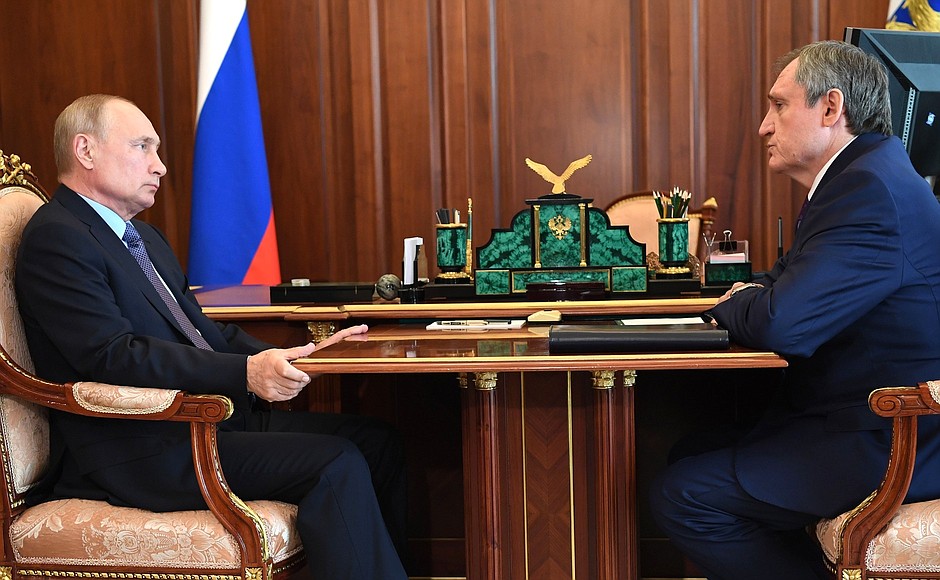
President of Russia Vladimir Putin: Mr Shulginov, let’s talk about the results. Now is a good time to summarise the results of the first six months of 2020, as well as for 2019. What do you think?
RusHydro Chairman of the Management Board and General Director Nikolai Shulginov: Mr President, in 2019 RusHydro marked its 15th anniversary. Thank you for your greetings to our 70,000 members of staff. Over these 15 years, RusHydro has transformed from a company founded on the basis of RAO UES hydropower stations into a major energy holding that generates all types of electricity except nuclear power. Our company is involved in all types of activity.
Last year, we completed the autumn and winter season as scheduled, supporting steady operation of our energy facilities and reliable power supply to consumers of electric power and heating. Our core consumers are, of course, based in Russia’s Far East. The Far Eastern macro region is the main region of presence for RusHydro, even more so because electricity consumption in the Far East is growing faster than the nationwide average. In 2019, the Eastern Integrated Energy System and isolated energy grids roughly covering the Far Eastern Federal District in its former boundaries accounted for a 3.3-percent growth while the overall nationwide consumption slightly declined.
We have seen the same trend this year as well. We have seen a 4.4-percent growth and the year-on-year growth did not stop in 2020 even during the pandemic and it continues. It is a challenge for us and the Far Eastern energy facilities and we need to respond to it. Our power stations’ workload is increasing. The load factor of the installed capacities of the Eastern Integrated Energy System TPP is higher than in the Unified Energy System. Of course, this requires resources. However, the Russian Federal Anti-Monopoly Service has not dealt with taking the shortfall in revenue and our economically substantiated expenses into account when calculating the rates of the Far Eastern Generating Company.
I would like to suggest that you look at a few figures from 2019 and the beginning of this year. Installed capacity increased to 39.7 gigawatts after new power units went on stream and the existing ones were upgraded.
The total electricity generation in 2019 was 143 billion, higher than in the last three years. In the first quarter, output grew 19 percent year on year, and in June, by as much as 22 percent, mainly due to hydroelectric power stations. Water was especially high this year, so power generation is also much higher than in previous years.
As for financial indicators, revenue grew 2 percent in 2019 compared to the previous period; in the first quarter, the rise was 7.5 percent. We certainly expect further growth in revenue, as a consequence of increased inflow, generation at hydropower stations and higher consumption in the Far East, which needs to be met.
Our IFRS net profit before adjustment for impairment of value of the new facilities in the Far East amounted to 52 billion rubles. We need to make this adjustment because the return on investment is not taken into account when tariffs are 100 percent regulated.
Profit in the first quarter grew 57 percent. We believe there will be further growth. Taxes rose 3 percent over the past year, and investment amounted to 93 billion, up 12 percent. According to our dividend policy, we expect dividends to be about the same as last year. Capitalisation growth was 52 percent from January 1, 2019, and 31 percent in 2020. This is the result of our systematic efforts to improve production and financial indicators, and to optimise managed costs.
Regarding investment, we commissioned several new facilities, the main ones being at the Nizhne-Bureyskaya HPP last year, about which you know, and the Sakhalinskaya GRES-2. It was the third of the four power plants to be put into operation under your Executive Order No. 1564 issued in 2012. We also put into operation the Zaramagskaya HPP-1 in December, the construction of which began back in the Soviet period, and the small-scale Verkhnebalkarskaya HPP at an altitude of 1,000 metres. This year we have also launched the small-scale Ust-Dzhegutinskaya HPP and a TPP in Sovetskaya Gavan, the last of the four stations to be completed under your executive order.
In addition, we continue to modernise HPP equipment in order to increase their capacity. Over the past year, we have connected 20,000 users to electricity lines with a capacity of 773 MW.
As for our five-year investment plans, we do not intend to downgrade them. Moreover, we propose increasing them. Our plan for 2020 includes the TPP in Sovetskaya Gavan, the Srednekanskaya HPP and the integration of the Pevek-Bilibino power lines due to the decommissioning of the Bilibinskaya nuclear power plant in Chukotka. We will also continue building small-scale HPPs in the North Caucasus.
So, why have we asked to increase investment by 171 billion rubles? The TPP modernisation programme in the European part of Siberia and the Urals was launched last year. Unfortunately, we cannot start a similar modernisation and construction programme in the Far Eastern Federal District. You have supported the list of such TPPs and the programme in general, and the Government has issued a resolution that includes the list. This five-year programme will cost approximately 171 billion rubles in the prices of the first quarter of 2019. We are currently at the design stage, and the programme is to be completed before 2026.
We are asking you to expedite the Government and the State Duma’s adoption of regulations on the establishment of a mechanism guaranteeing a return on investment in the Far East, so that we can launch this programme. This will have a multiplier effect for the further development of power engineering, construction companies, new jobs, taxes, and so on. I will submit our request in writing.
Vladimir Putin: Yes, please do this. Thank you.
<…>